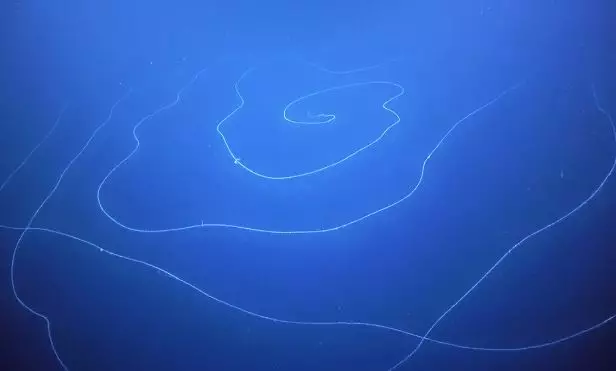
A strange sea creature has been spotted off the coast of Australia. Take a look below:
Known in some places as the 'long, stringy, stingy thingy', it is in fact a siphonophore which, though it appears to be one animal, is actually many thousands of smaller organisms.
Advert
These are called zooids, where each organism in the colony performs a different function, such as attracting food, reproducing or defending the colony from predators.
Scientists have known about them for many years, but new footage shared by the Schmidt Ocean Institute from an expedition off the coast of western Australia shows the span of the siphonophore's enormous tentacles.
When quizzed about its size on Twitter, the scientists responded: "This siphonophore's outer ring measured in at 15m (49ft) diameter, so just that ring *alone* seems to be approximately 47m (154ft)!"

The breathtaking images were taken by researchers on the Ningaloo Canyons Expedition. Scientists used remote technology to analyse the marine life and were bringing the device up to the surface when they came across the majestic creature.
Advert
Speaking about the discovery, Nerida Wilson and Lisa Kirkendale from the Western Australian Museum told ScienceAlert they just couldn't believe what they were seeing.
They said: "Everyone was blown away when it came into view.
"There was a lot of excitement. People came pouring into the control room from all over the ship. Siphonophores are commonly seen but this one was both large and unusual-looking.
"Although the ROV pilots made an estimate of its length, it has yet to be formally measured.
Advert
"However, it does appear to be longer than any other animal on the planet."

Explaining more about the mechanics of the siphonophore, Stefan Siebert of Brown University said it was best to think of zooids similar to organs.
He told Wired: "In a way these specialized bodies function as organs. Some move the colony, some feed for the colony, some take care of reproduction.
Advert
"Whereas creatures like you and me have over millennia evolved different parts of our bodies to work as organs, siphonophores have evolved individual bodies themselves into organs. It's a bit like your liver up and declaring independence from the rest of you, even though it can't go anywhere."
He added: "Like any other animal, siphonophores start off with a single fertilized egg. And this egg develops into a small larva, and at some point this larva will develop its first tentacle, and it has a mouth opening by then.
"Siphonophores have along the stem one long axon, which probably propagates signals from one end of the colony to the other. But how they coordinate all this and how the whole colony appears to act as an animal, it's really not well understood."
Featured Image Credit: @SchmidtOceanTopics: Science, World News, Interesting, Weird